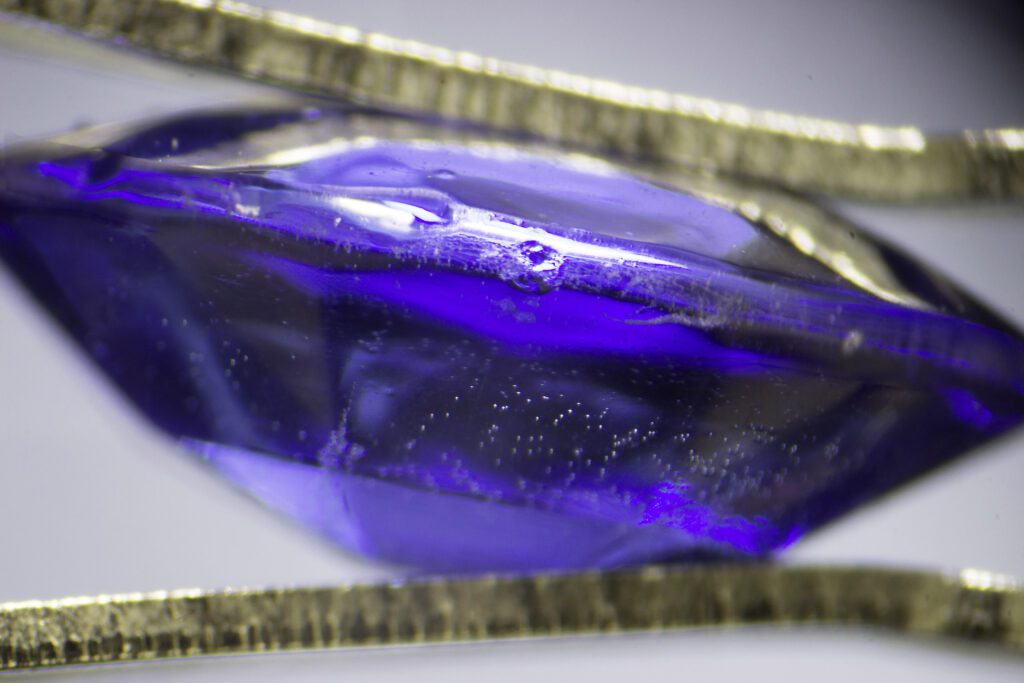Sarah Steele FGA DGA discusses the many simulants of one of Britain’s most famous native gemstones, Whitby jet.
If imitation is the sincerest form of flattery, then Whitby jet must be a very desirable material indeed. I can think of perhaps 20-30 different materials, both natural and synthetic, which, at one stage or another over the years, have been described as Whitby jet.
We think of a 40-year period during the mid to late nineteenth century as the heyday in Whitby jet manufacture, and from a jewellery output perspective that is unequivocally true. However, the desire for Whitby jet, and the quest to imitate it, has its roots much further back in time.
Read more: Reconstructed Amber Broken Down
Following the Scottish Gemmological Association’s Conference this year, delegates had the opportunity to visit the ‘Celts’ exhibition at The National Museum of Scotland. I couldn’t resist the opportunity to join them in having a closer look at the museum’s stunning collection of Bronze Age jet neckpieces whilst we were there.
Historically, many of these early pieces containing black beads with high organic carbon content were described as Whitby jet. Modern analytical techniques have shown, however, that these almost always contain a variety of materials – Whitby jet, certainly – but also oil shales, lignites and cannel coals, often within the one piece of jewellery.
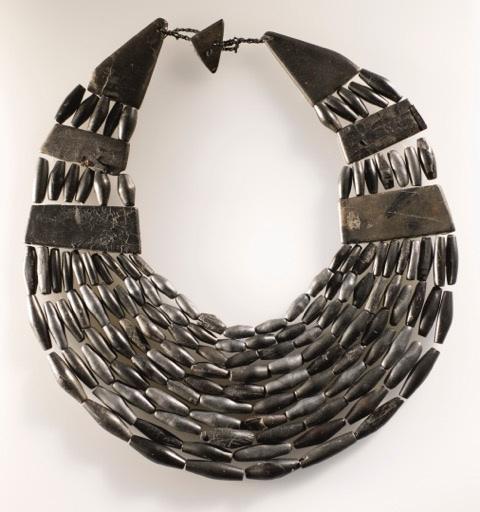

Whitby jet is a material with which the demand for rough will always outstrip supply in periods of high production, and jet collection requires patience as it is reliant on coastal erosion. Are we then, in the Bronze Age some 4,500 years ago, seeing the first example of a Whitby jet simulant? It has to be noted that the prevalence of Whitby jet in the archaeological record during this period suggests that it is arguably one of the oldest economic resources in the British Isles.
Fast forward 2,670 years and the Whitby jet simulant market is a fascinating and booming industry. British society is participating in a national obsession with mourning. With the death of George IV in 1830, the Lord Chamberlain’s office dictates the dress code for the period, stating unequivocally that “the ornament shall be jet”. In 1830 the term ‘jet’ meant only one material: Whitby jet. The death of the Duke of Wellington in 1852 prompted the production of Whitby jet jewellery into overdrive – the 50 recorded workshops in 1850 swelled to 204 following the death of Prince Albert in 1861, as yet another wave of mourning swept the nation.
Read more: From Elizabeth I to Elizabeth Taylor with John Benjamin FGA DGA
Demand for rough Whitby jet was beginning to outstrip supply and other options were needed. The main attraction of Whitby jet as a gem material was of course its deep black colour and liquid-like lustre, but more importantly its low specific gravity (SG) 1.2-1.3. It was fine to look ‘weighed down’ by the convictions of your expression of mourning, but it was practical if the seven strings of beads you wore to denote that you were the seventh daughter of a deceased father, didn’t weigh more than a few ounces.
Therefore, to be a convincing simulant of Whitby jet, the imitation material would need to be light in weight. Whitby jet is also a poor thermal conductor and so always feels warm, as heat is not quickly transferred away from the surface. Today we often describe jet as feeling ‘plasticky’, however, in the mid nineteenth century plastic was yet to be discovered. The simulant therefore needed to be light in weight, black in colour and a poor conductor of heat.
Horn and tortoiseshell
In 1712 John O’Bisset discovered horn could with the application of heat, be moulded into various shapes. When cooled the shape was retained – O’Bisset had discovered the first natural thermoplastic material. Sheets of horn were put between hot metal plates in a press and pressure applied. Placing the warmed horn into moulds before applying pressure enabled the production of horn boxes, beakers and other items. With the application of black dye, pressed horn was a good candidate for a simulant of Whitby jet and many jewellery items were produced.
Horn has a tendency to delaminate due to its layered structure, so loupe examination often reveals these layers, especially on the reverse of brooches. Any damage to the edges also gives a slight transparency to the damaged area, which is not seen in Whitby jet. The colour can often seem uneven and it is not possible to screw a brooch fitting into jet. Therefore a screw, often seen in horn, is always a sign of a simulant.
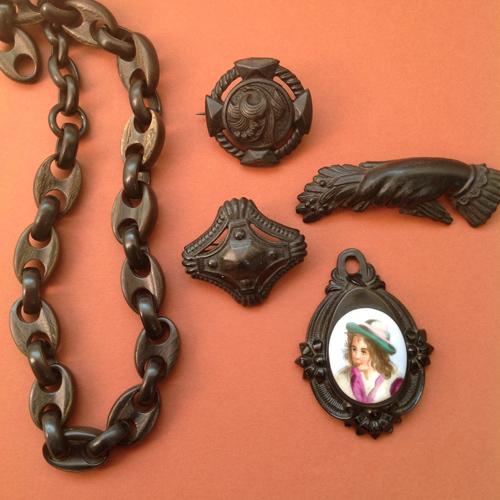

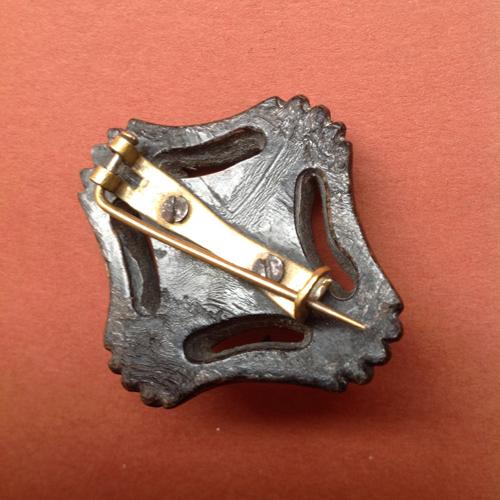

Top: Pressed horn jewellery items. Below: The reverse of a pressed horn brooch showing lamination and screw fittings
It is also worth mentioning that tortoiseshell, like horn, is also a natural thermoplastic. Tortoiseshell, a much admired decorative material, derives not from a land tortoise but from certain species of marine turtle, principally the relatively small hawksbill. Tortoiseshell is unlikely to be mistaken for jet due to the mottled colour, but the SG and ‘plasticky’ feel are similar.
Bog oak
Whitby jet is a fossilised wood, so perhaps a wood product could also make a suitable simulant. Bog oak is not a specific species, rather a term that indicates wood that has been buried in a peat bog for thousands of years. The extremely low oxygen conditions of the bog protect the wood from normal decay. While the underlying peat provides acidic conditions where iron salts and other minerals react with the tannins in the wood, gradually giving it a distinct dark brown to almost black colour.


Bog oak jewellery
Bog oak occurs in many areas of the United Kingdom but jewellery usually originates from Ireland. It was produced from the early 1800s but became popular in the mid nineteenth century, reflecting the demand for Whitby jet, especially after 1852, when techniques to mass-mould and decorate the material (through the application of hydraulic or heated pressure to the dried wood) were invented.
Although predominantly used for mourning jewellery as a cheap substitute for Whitby jet, bog oak was also worn to support Irish crafts, with pieces often carved or stamped with Gaelic motifs such as harps or shamrocks – symbols not normally found in mourning jewellery. Concentric rings are usually visible on the reverse of items as blanks were lathe-turned prior to carving. Loupe examination always show the ligneous nature of the wood and the lustre achieved is usually textured and dull.
Vulcanite
In 1839 Charles Goodyear discovered the method of mixing sulphur with rubber to form hardened or vulcanised rubber, called Vulcanite. The proportion of sulphur can be increased or decreased in order to vary the required amount of hardening accordingly. Between 25-50% sulphur gives a hard product with the familiar feel of plastic. There are many Victorian vulcanite objects, but the most common form is an imitation of Whitby jet used widely in the production of brooches, bracelets and necklaces. Vulcanite could be produced in almost any colour, although the predominant colours are black (ebonite) and brown. As a result, vulcanite was by far the most widely-produced Whitby jet simulant. Unlike pressed horn a thermoplastic materials which, if heated again can be re-moulded into a different shape. Vulcanite is a thermoset material which, after moulding becomes brittle and cannot be remoulded.
Vulcanite can be distinguished from jet relatively easily. If the material has been exposed to light over time it loses its black colour and becomes khaki brown. When rubbed, vulcanite smells strongly of sulphur and brooch pins are usually screwed into position rather than glued. Chain links only show one or two splits depending on the link style as the link can be twisted open and then closed. In comparison in Whitby jet links, where every other link in the chain is cut and glued and will always show two or three cuts depending on the style of link. As vulcanite pieces were often moulded from jet originals the same design is seen regularly and, with experience, can be identified easily. (Please note: the ‘streak’ test on vulcanite will reveal a light brown streak similar to that of hard Whitby jet and so should not be relied on).
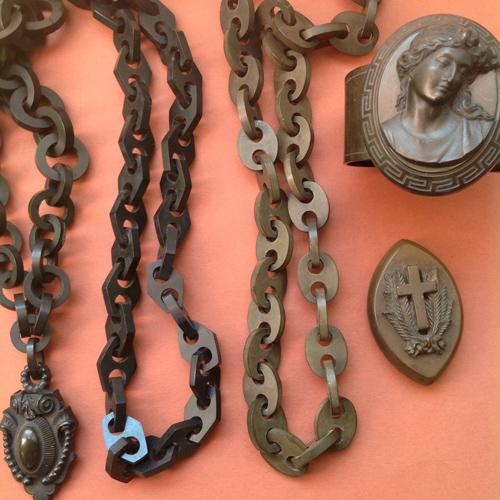

Examples of vulcanite jewellery. Items with little exposure to light remain black (left). Items that have been exposed to light show the typical khaki colour (right)
Bois durci
In 1855 Francois Charles Le Page secured a French patent for a method of combining blood albumen from slaughterhouses, with wood powder to form a plastic mouldable material he called bois durci. The wood dust (either ebony or rose wood), was mixed with blood, dried and then ground to a fine powder. The powder was placed in a steel mould and steam heated to 150-250°C in a powerful hydraulic press. After half an hour the mould was plunged into cold water. The resulting wood product was an extremely dense, highly polished and resistant thermoset material.
Le Page is reported to have used the marketing strapline “Anything Whitby Jet could do, bois durci could do cheaper and in brown”. The most common items available in bois durci today are circular plaques showing royalty or statesmen of the time. They are generally brown and often have bois durci stamped on the reverse.
French jet and Vauxhall glass
As far as Whitby jet imitations go French jet, along with vulcanite one of the most common. Glass items were also produced in large quantities during the Whitby jet heyday, primarily faceted black glass beads referred to as French jet.
Its higher SG, vitreous lustre and glass moulding marks mean it is unlikely to confuse French jet with Whitby jet. However, because many of the designs were so innocuous, finding a nineteenth century piece of French jet and identifying it from a piece of black glass, used all the way through to the 1940s, can be difficult for collectors of the material.
Vauxhall glass is often referred to as the English version of French jet, however all French jet was not of course produced in France! This thin highly reflective mirror glass was produced by a silvering process. The silvering is often seen on the reverse – either intact or in residual traces.
Spanish jet
Although all the above impacted the Whitby jet industry, it was a natural jet which was finally responsible for the industry decline. By 1870 the Whitby jet industry reached its peak, before catastrophically collapsing. There were undoubtedly a number of reasons. Some blamed the terrific demand, which had outstripped supply and lead to a fall in standards of workmanship, as many workers hadn’t had the basic training. The large number of simulants also cannot have helped, but the final death knell was heralded by the arrival from the continent of Spanish jet. It is hard to estimate how much of this material was imported from Asturias, but it is first documented in 1874 and many tonnes seem to have been available.
The Spanish jet trade had flourished between seventh and sixteenth centuries, and whilst the Spanish supply undoubtedly had some very good quality rough material, it seems that Whitby imported a rather poor quality jet, often containing pyrite, making it unstable. Finished pieces degraded quickly, cracked and crumbled. As a result, consumer confidence in an already struggling product sector collapsed.
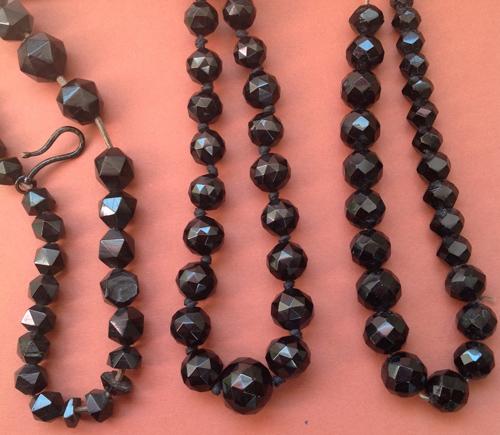

Three faceted bead necklaces, cracked and crazed beads, likely Spanish jet (left), Whitby jet, showing high lustre and sharp facet edges (centre), French jet with chips and abraded facet edges (right)
Decline of the industry
In 1889 the Whitby Gazette reported “It would have been better for the Whitby jet Industry, and better for art development, if the Spanish jet trade had never been known in Whitby”. Despite desperate measures to support the Whitby jet industry, such as a quality mark scheme, the industry didn’t recover. The mourning trend was well and truly over.
In 1915 The Lady described the Whitby jet trade as “A somewhat funereal fetish of fickle fashion”. Poor recognition for the greatest lapidary trend our nation, and perhaps the world has ever seen.
The beginning of the twentieth century may have heralded the end of the Whitby jet mourning jewellery trend, but it didn’t signal the end of the road for the use of plastics in jewellery. In 1899 we saw the introduction of casein formaldehye; milk curds hardened with formaldehyde giving us such famous trade names as Galilith, and of course in 1907 phenol formaldehye, with wood flour or other filler as powder gives us the trade name Bakerlite. Galilith and Bakerlite were never used to imitate Whitby jet jewellery – by this time (and forgive the pun) you wouldn’t have been seen dead in this outdated material.
It seemed like the end of the road for Whitby jet. The last apprenticed jet worker Joe Lyth died in 1958, and with him died the secrets of the Victorian era. However, the last 30 years or so we have seen a revival in fortunes within the Whitby jet trade. Today there are 11 manufacturers in Whitby town. As mentioned previously, demand for rough Whitby jet is high and patience is required for collection of beach material. This has allowed poor quality materials, primarily Siberian cannel coals and Georgian jet (both often referred to as Gagate) with its poor stability and high porosity to enter the supply chain.
Georgian jet is becoming increasingly common as finished contemporary style jewellery made by Baltic amber manufacturers, and within the last 12 months as antique style beads from an undisclosed source. Attempts were even made to sell rough to unsuspecting workshops in Whitby. Experienced lapidaries however quickly identified the new foreign imposter. In Whitby we have no issue with Georgian manufactures producing items from their indigenous jet, but lack of disclosure of origin leads to the material being retailed as Whitby jet somewhere along the pipeline.
Nomenclature and appellation of origin is, as always, crucial to price. A good Whitby jet string of Victorian beads is worth £300 upwards, the Georgian imitation probably nearer £20, so caveat emptor!
As a lapidary in Whitby, I know that the Whitby jet trade will, as always fight back against the latest simulants. A true jet to rival the beauty or stability of Whitby jet has yet to be discovered, but it does make me proud to think that for the last 4,500 years Whitby jet has been held with such reverence that many have tried to emulate it. With the desire of the Victorians to find the perfect simulant, Whitby jet was in part perhaps responsible for the birth of the modern plastics industry, and therefore the modern world as we know it. ■
This article originally appeared in Gems&Jewellery May/June 2016 / Volume 25 / No. 3 pp. 16-20
Interested in finding out more about gemmology? Sign-up to one of Gem-A’s courses or workshops.
If you would like to subscribe to Gems&Jewellery and The Journal of Gemmology please visit Membership.
Cover image fine Whitby jet cameos including King Oswy and his bride (centre) and Bejamin Disraeli (right). Photo Credits Sarah Steele, except where otherwise stated.
{module Blog Articles Widget}



